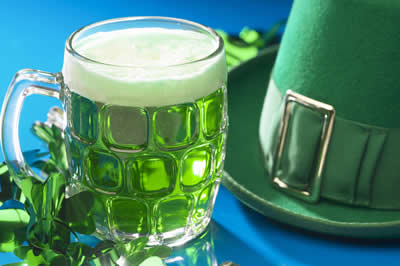| Outage Alert! |
| If you are trying to reach us today; Tuesday March 16 ...HMC Office is dealing with phone and interrnet interuption due to a Comcast outage. RDNews is being published today via a netbook! |
| RD Poll |
Don't forget to send in your Holiday pix...of plated up food, table settings, decorations, and festivities surrounding  St. Patricks Day. Please email photos to Pati, we'll showcase some in future issues. (Please do not include people in the photo unless you have a signed media release from them.) St. Patricks Day. Please email photos to Pati, we'll showcase some in future issues. (Please do not include people in the photo unless you have a signed media release from them.) |
|
Food For Thought |
If your facility is changing the menu to provide the traditional corned beef, cabbage, potatoes and carrots, please make sure the changes are recorded on all the menus posted in the facility and the RD has made/approved the changes appropriately on the therapeutic diet menus. Refer the facility to the HMC website if they are interested in ordering holiday and theme menus/recipes.
 Feel free to send me your food and menu related questions. Feel free to send me your food and menu related questions.
Janet Montano, RD Director of Menu Services |
| National
Nutrition Month |
National Nutrition Month
provides many opportunites to share with others about good choices in nutrition. Check out games and quizes on the eatright site. |
| Contact the Editor |
 Please send your RDNews comments, suggestions & questions to Judy Morgan, MBA, RD Please send your RDNews comments, suggestions & questions to Judy Morgan, MBA, RD | |
|
Greetings!
St Patrick's Day and all is green and blarny! Can you smell the corned beef and cabbage? Read on for a delightful and interesting story about this holiday submitted by Julie Tharalson, RD, Culinary Director. |
|
|

Corned Beef Or Bacon?
How Irish Is Your St. Patrick's Day Feast?
What's the first thing that comes to mind when you hear "St. Patrick's Day?" Corned Beef? Cabbage? Green Beer? It's a safe bet that the majority of facilities we serve, whether or not they use HMC Menus, will be serving Corned Beef and Cabbage at some point on that day. However, if we look deeper into the history of this traditional menu, we'll find that it's actually quite untraditional from the viewpoint of an Irishman.
The often loud, raucous party that's become commonplace to celebrate St. Patrick's Day in this country started as a more solemn way for Irish Catholics to remember the Scottish born saint on the anniversary of his death in about 460 AD. During the 19th Century St. Patrick's Day took on more importance to Irish immigrants in the United States who were looking to connect with fellow expat countrymen. Over time, the observation took on a more celebratory feel which eventually spawned parades, most notably in New York and Boston that helped boost Celtic Pride.
Many of the Irish immigrants coming to this country were escaping the great potato famine of the mid 1800's. Potatoes were an important dietary staple among working class Irishmen.  A typical meal that might be eaten in observation of St. Patrick's Day would likely include boiled potatoes, cabbage and Irish bacon or salt pork. Among the Irish immigrants in America, corned beef was found to be a good (albeit Americanized) replacement for the more expensive bacon/pork. Over time, the replacement "stuck". A typical meal that might be eaten in observation of St. Patrick's Day would likely include boiled potatoes, cabbage and Irish bacon or salt pork. Among the Irish immigrants in America, corned beef was found to be a good (albeit Americanized) replacement for the more expensive bacon/pork. Over time, the replacement "stuck".
Green Beer? Well, that's a story for another time! |
|
RD Tip |
|
Traditional Irish recipes often feature very simple techniques and ingredients. Potatoes, cabbage, butter and onions are featured often in Irish cuisine and figure prominently in the recipes below.
Two potato dishes, Champ and Colcannon are very similar in that they are mashed potatoes with greens mixed in. The difference is in the greens: Champ gets a good dose of green onions and Colcannon is essentially the same recipe but uses cabbage in place of the onions.
 Champ Champ
2 large Russet potatoes
1 c. milk (not skim)
½ c. butter (one stick)
1 bunch green onions, washed, trimmed and thinly sliced
½ tsp each salt and pepper (or more to taste)
1. Add 2 quarts water and 1 tsp salt to a large pot over high heat.
2. Peel and quarter potatoes and add to pot, leave pot uncovered.
3. While potatoes are cooking, add milk to small saucepan and place over low heat.
4. When water comes to boiling, reduce to medium high heat and simmer potatoes until tender. Insert a knife into one of the potatoes, when there is no resistance the potatoes are done.
5. Drain potatoes in a colander or sieve. Place foil over the top to keep warm.
6. Add butter and onions to the same pot over medium heat, stir until onions are tender. If using a sieve to drain the potatoes, take a rubber spatula and push the potatoes thru the sieve into the pot with the butter and onions. Alternately you may use a food mill, potato ricer to process the potatoes or an old fashioned potato masher after adding the drained potatoes to the pot.
7. Once the potatoes are sufficiently processed. Add the salt, pepper and half the warmed milk to the pot and stir. If the potatoes are too dry, add the remainder of the milk and stir.
8. Taste and add more salt and pepper if needed. Serve at once.
Makes about 4 servings. |
| Dear Dietitian; |
Happy St. Patrick's Day everyone! We hope you enjoy the potato recipes and maybe even consider trying one for your St. Patty's day feast this year. Thanks for taking the time to read about this topic.
Julie Tharalson, RD, Culinary Director
HM Composite, Inc. | |
|
|
|